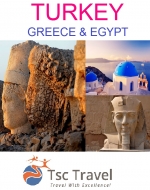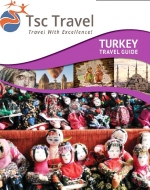ABOUT TURKEY
Language: Turkish
Capital: Ankara
Government: Parliamentary Republic
Founder: Mustafa Kemal Ataturk
Size: 779.452 km2
Currency: Turkish Lira (TL)
Time Zone: EET (UTC)
History
 Earliest records of Turkish people show their ancestors lived in Central Asia sometime before 2000 BC.
Earliest records of Turkish people show their ancestors lived in Central Asia sometime before 2000 BC.
By the 10th century, most Turks adopted the religion of Islam. Some Turks traveled southwest to Anatolia (Asia Minor) considered the cradle of civilization because it has embraced more than 20 cultures and civilizations. These civilizations included the Hittites, Assyrians, Lydians, Greeks, Persians, Macedonians, Bosnians, Romans, Byzantines, and Turks.
In AD 1071, the Seljuk Turks conquered over the Byzantine Empire but after their influence declined, Anatolia fragmented into many smaller states. Ottoman Turks unified these separate states and became the largest empire in recent history.
The Ottomans ruled for more than six centuries (1081 - 1922), mostly without competition because they allowed flexibility and diversity in religion, language, and culture. Upon being on the losing side in World War One, their empire was due to be carved up among the Allies but a man called Mustafa Kemal Ataturk led the Turkish people in a War of independence (1919-1922).
Occupying forces were pushed back and in 1923, the Republic of Turkey was established. As the leader of a new nation, Ataturk created foundations for a modern, secular state based on human rights and fundamental freedoms.After World War II, Turkey, become a member of NATO, OECD, the Council of Europe, and other major Western organizations.
When to Go?
 The South and West coasts have a typical Mediterranean climate of hot summers and mild winters. The humidity is a little high during summer in these regions.
The South and West coasts have a typical Mediterranean climate of hot summers and mild winters. The humidity is a little high during summer in these regions.
The swimming season is from June to September along the Marmara and North Aegean coasts, while it is from April to October on the South Aegean and Mediterranean coasts. The Black Sea Region has a moderate climate; the summers are warm and winters are mild. In this region, rainfall is heavier than elsewhere in the country.
The swimming season in the Black Sea Region is from June to early September and the weather is not so dependable. There is quite a difference between the coastal regions and the inland regions, which are at higher altitudes.
The climate reaches extremes in central and Eastern Anatolia with hot, dry summers when the temperatures may reach 42°C, and cold, snowy winters. Spring and autumn are best for sightseeing and traveling.
Further Reading About Turkey
Travel Tips: Includes money and credit cards, driving in Turkey, visa requirements, visiting mosques and much more
Tours Around Turkey: Read about the places we go to including Istanbul, Ephesus, Pamukkale, the Black sea and Cappadocia
Read our Turkey Travel Guide


